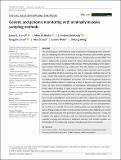Files in this item
Genetic and genomic monitoring with minimally invasive sampling methods
Item metadata
| dc.contributor.author | Carroll, Emma L. | |
| dc.contributor.author | Bruford, Michael | |
| dc.contributor.author | DeWoody, J. A. | |
| dc.contributor.author | Leroy, G | |
| dc.contributor.author | Strand, A | |
| dc.contributor.author | Waits, L | |
| dc.contributor.author | Wang, J | |
| dc.date.accessioned | 2018-03-27T11:30:06Z | |
| dc.date.available | 2018-03-27T11:30:06Z | |
| dc.date.issued | 2018-08 | |
| dc.identifier | 251887195 | |
| dc.identifier | faab9da3-7c42-4704-a423-c57ad8e08d28 | |
| dc.identifier | 85044222012 | |
| dc.identifier | 000439505200006 | |
| dc.identifier.citation | Carroll , E L , Bruford , M , DeWoody , J A , Leroy , G , Strand , A , Waits , L & Wang , J 2018 , ' Genetic and genomic monitoring with minimally invasive sampling methods ' , Evolutionary Applications , vol. 11 , no. 7 , pp. 1094-1119 . https://doi.org/10.1111/eva.12600 | en |
| dc.identifier.issn | 1752-4571 | |
| dc.identifier.uri | https://hdl.handle.net/10023/13027 | |
| dc.description | Funding: Marie Slodowska Curie Fellowship, (Behaviour-Connect) funded by the EU Horizon2020 program (ELC). | en |
| dc.description.abstract | The decreasing cost and increasing scope and power of emerging genomic technologies are reshaping the field of molecular ecology. However, many modern genomic approaches (e.g., RAD-seq) require large amounts of high quality template DNA. This poses a problem for an active branch of conservation biology: genetic monitoring using minimally invasive sampling (MIS) methods. Without handling or even observing an animal, MIS methods (e.g. collection of hair, skin, faeces) can provide genetic information on individuals or populations. Such samples typically yield low quality and/or quantities of DNA, restricting the type of molecular methods that can be used. Despite this limitation, genetic monitoring using MIS is an effective tool for estimating population demographic parameters and monitoring genetic diversity in natural populations. Genetic monitoring is likely to become more important in the future as many natural populations are undergoing anthropogenically-driven declines, which are unlikely to abate without intensive adaptive management efforts that often include MIS approaches. Here we profile the expanding suite of genomic methods and platforms compatible with producing genotypes from MIS, considering factors such as development costs and error rates. We evaluate how powerful new approaches will enhance our ability to investigate questions typically answered using genetic monitoring, such as estimating abundance, genetic structure and relatedness. As the field is in a period of unusually rapid transition, we also highlight the importance of legacy datasets and recommend how to address the challenges of moving between traditional and next generation genetic monitoring platforms. Finally, we consider how genetic monitoring could move beyond genotypes in the future. For example, assessing microbiomes or epigenetic markers could provide a greater understanding of the relationship between individuals and their environment. | |
| dc.format.extent | 26 | |
| dc.format.extent | 1325636 | |
| dc.language.iso | eng | |
| dc.relation.ispartof | Evolutionary Applications | en |
| dc.subject | Wildlife management | en |
| dc.subject | Wildlife forensics | en |
| dc.subject | Population demography | en |
| dc.subject | Conservation genetics | en |
| dc.subject | DNA fingerprinting | en |
| dc.subject | Individual identification | en |
| dc.subject | Non-invasive genetic sampling | en |
| dc.subject | Next-gen genetic monitoring with MIS | en |
| dc.subject | QA75 Electronic computers. Computer science | en |
| dc.subject | QH301 Biology | en |
| dc.subject | QH426 Genetics | en |
| dc.subject.lcc | QA75 | en |
| dc.subject.lcc | QH301 | en |
| dc.subject.lcc | QH426 | en |
| dc.title | Genetic and genomic monitoring with minimally invasive sampling methods | en |
| dc.type | Journal item | en |
| dc.contributor.sponsor | European Commission | en |
| dc.contributor.institution | University of St Andrews. School of Biology | en |
| dc.contributor.institution | University of St Andrews. Sea Mammal Research Unit | en |
| dc.identifier.doi | 10.1111/eva.12600 | |
| dc.description.status | Peer reviewed | en |
| dc.date.embargoedUntil | 2018-03-24 | |
| dc.identifier.grantnumber | 656774 | en |
This item appears in the following Collection(s)
Items in the St Andrews Research Repository are protected by copyright, with all rights reserved, unless otherwise indicated.

